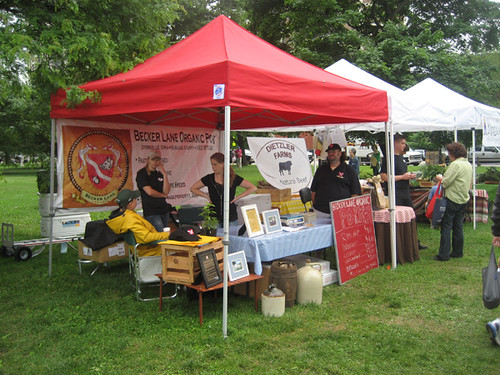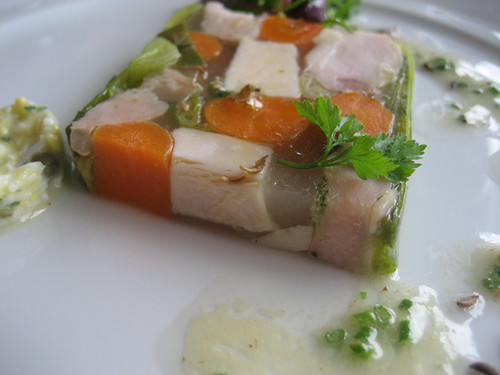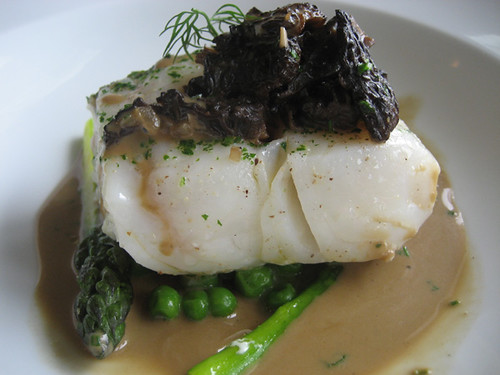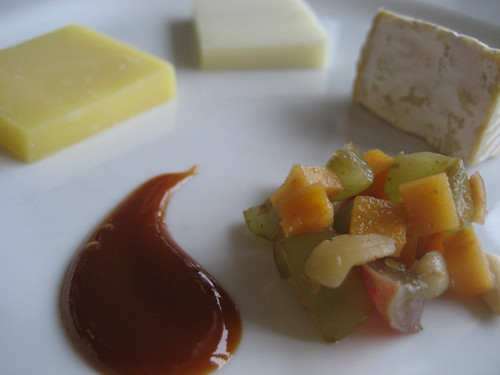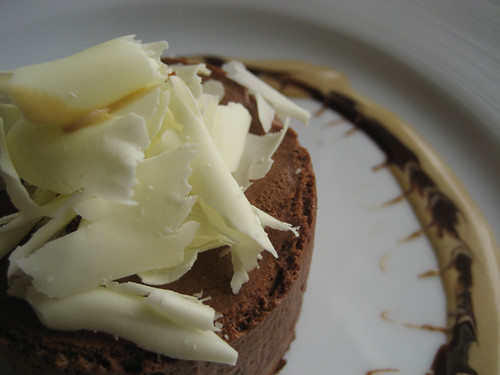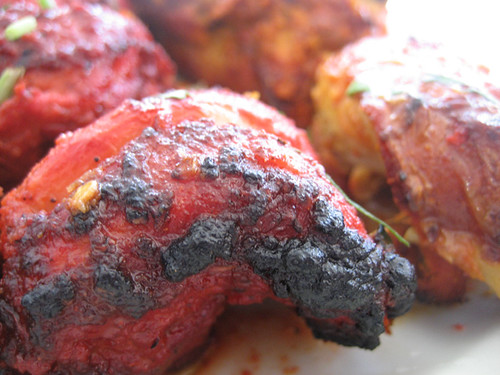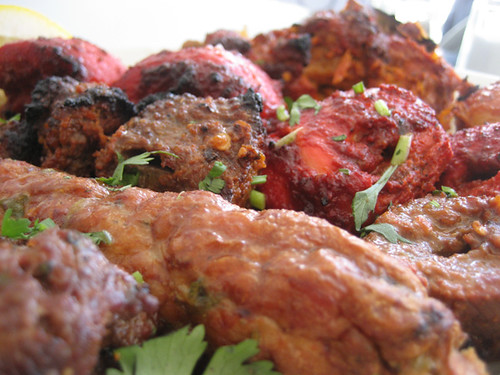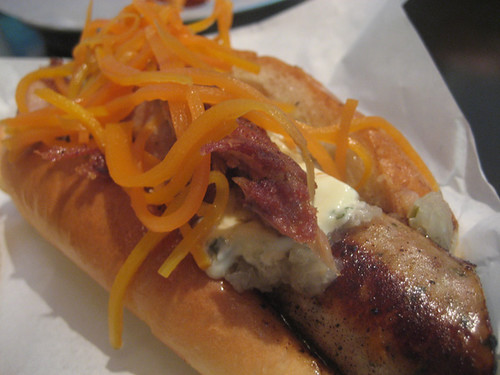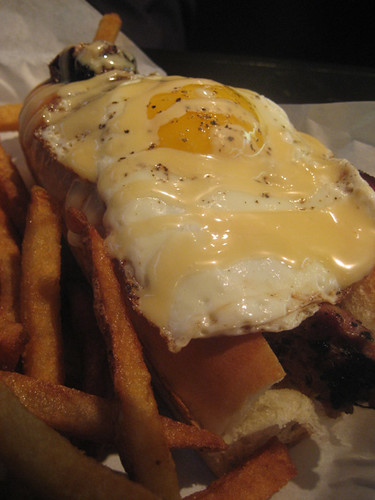
Happy anniversary, my sweet…
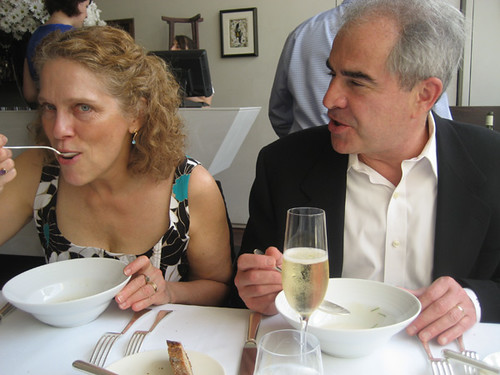
…and thank you, good friends, for the champagne with which to toast it.
Since the first time I went to Blackbird, which was between my ceasing to post on Chowhound and the launching of LTHForum, and is therefore a meal tragically lost to history, the only time I had been there to eat (as opposed to, say, butcher hogs in the basement) was for the mulefoot pig dinner. Mike Sheerin, the chef Paul Kahan brought in from WD-50 in New York to take over primary chef duties as his empire expanded with The Publican, had only been on the job a few months, and of the five main courses at the mulefoot dinner, his was the one that I was least excited by, which I took to mean nothing more about his abilities than that it was built on enoki mushrooms, which don’t do anything for me. But even with complaints about other parts of the Kahan empire possibly getting stretched thin talent-wise as Big Star opened, the word about Blackbird remained rock-solid, its perch at the top of see-and-be-seen downtown dining undisturbed. So it was time to check out what Sheerin was up to. When my 20th wedding anniversary began looming, knowing that it would fall as it always does during the National Restaurant Association show (when tables are at a premium), I decided early on to go to Blackbird, and planned to book a table the next day.
The next morning, Sheerin became Chicago’s only representative among the 2010 Food & Wine Best New Chefs.
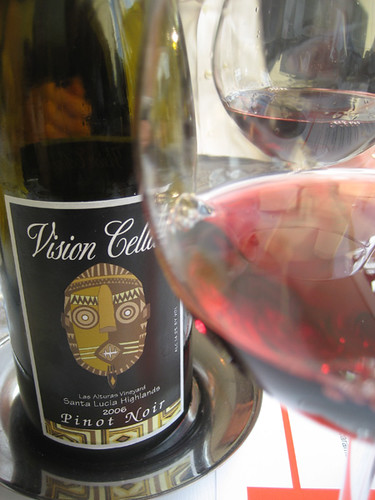
Ivar the World’s Greatest Waiter recommended this bottle from a producer “in the family,” as he put it.
But I snagged a table, just in time, and we went with David Hammond and his wife last Saturday. And as impressed as I’ve been in the past with Kahan & co. as an operation, I think the thing that maybe impresses the most about him now is that he’s hired someone who has reinvented his flagship restaurant right under his nose, and seems to be fine with it. (And it’s not like it’s because he’s not around, either; Kahan was on the floor in stained chef’s whites for much of our meal, a perfect symbol of Blackbird’s chic-meets-meatpacking-district ethos.)
I summarized what I thought was Kahan’s approach to food in something I wrote a year and a half ago (based, admittedly, on more experience with Avec than with Blackbird, and on what he and others said about The Publican’s intended approach):
What Kahan wants to do is serve food that tastes like the best example of that food you’ve ever had, and his restaurants aren’t shy about using every trick in the professional chef’s handbook to make that happen. Dishes are heavily salted (though rarely obviously salty), and you often hear the chefs talking about adding acid to a dish, both techniques for delivering a trumpet blast of flavor in your mouth that seems more intense and dramatic than you could produce at home. Still, there’s a line they don’t cross, the point at which a flavorful meat ceases to be itself; dishes are never dressed up with extraneous flavors, weird combinations for combination’s sake.
That still seems like a decent summary of the sensibility at work at Avec and The Publican, say. Salty, porky, bright and snappy deliciousness that invites you to order another beer or glass of wine and makes you full and happy. But Blackbird under Sheerin seems to be taking a subtler, more delicate turn. Even when you ate something cured or brined or pickled, it was balanced with something else, so it wasn’t a trumpet blast on its own. A couple of times, it even approached the level of playfulness with food that you associate with places like Alinea or Graham Elliott, which would be in line with Sheerin’s training at WD-50— though only a couple of times (and it is worth noting, the most extreme example was the very first course of the tasting menu, as if to get that over with quickly and get back to Blackbirdian no-nonsense-ness as quickly as possible). Overall, though, what you mainly take away is a sense that although Blackbird didn’t need wholesale reinvention, it did need sharper differentiation from its siblings Avec and The Publican, and that’s where it’s gone under Sheerin— a little less mad pork love, a little more elegance and refinement.
Here’s what’s on the tasting menu right now. I’ve stopped routinely taking photos when fine-dining out, because so many people do it better than me, especially in low-light conditions. In this case, an early table and placement near the window provided the perfect circumstances for my abilities, so I’m happy to stop talking and revel in food porn to give you the best idea of where this seminal restaurant is now.
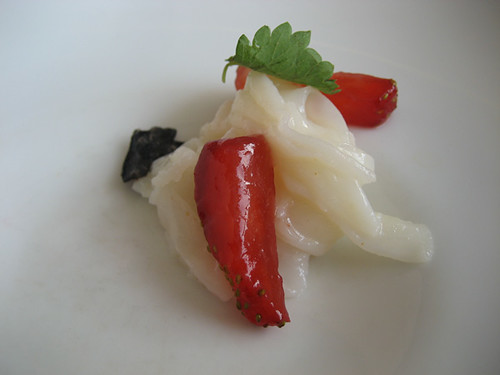
Cuttlefish “noodles” with strawberries and a bit of candied olive. (The menu also says rhubarb, though I defy you to find it.) This was the most playful, tricky thing, reminding me of Schwa’s jellyfish pad thai; but I just didn’t really like the fish-and-strawberries combo. The candied olive was more interesting, though so tiny a piece in this tasting portion that I can’t say I entirely got to taste it.
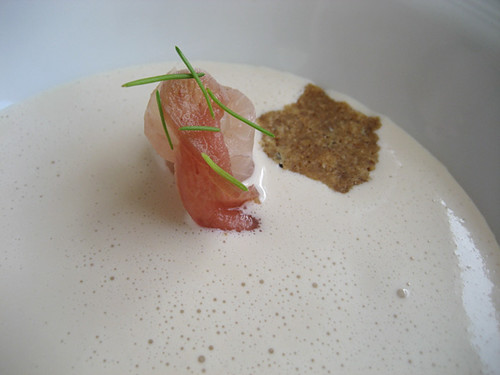
Peanut gazpacho with cured hiramasa, rhubarb (this time, visible), pine, peanut brittle and green peppercorn. This was a gorgeous cold soup, creamy and complex yet easy to like.
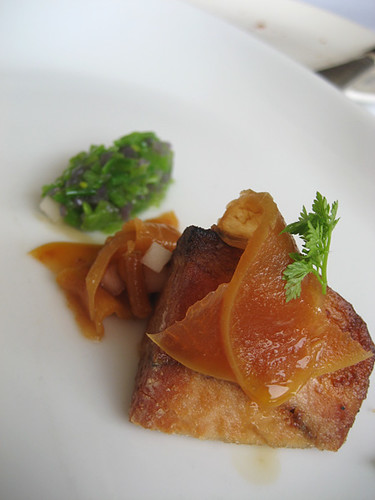
Swan Creek suckling pig with apricots stewed in Lillet, a little relish of snow peas and water chestnuts, and beer vinaigrette. So far as I’ve seen, Kahan’s restaurants don’t seem to have much use for Asian flavors, but Sheerin seems to like sneaking Asian vegetables in and letting them just be themselves. The pork was deeply satisfying, unctuous meat and crispy skin, and the winey apricots a perfect accompaniment, although this was one dish where you really felt like a tasting portion was cruel torment, it cried for a softball-sized hunk to tear into.
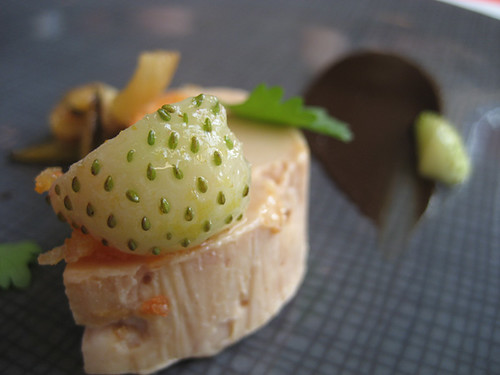
Foie gras torchon with black garlic dip, green strawberry, and shrimp salt (whatever that means), served with a glass of Sauternes. Interesting, using the tar-strong black garlic to challenge the more familiar fatty pleasures of foie gras; not the most likable thing we ate, but points for thinking hard and not taking the easy route.
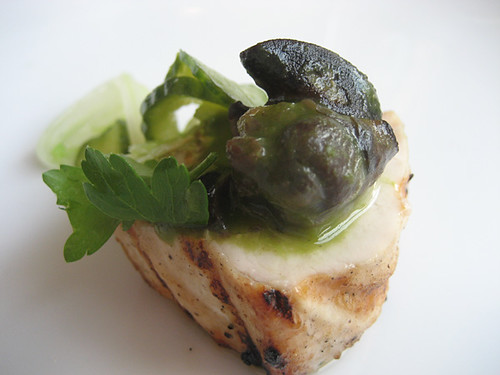
Wood-grilled sturgeon, garlic-braised snail, smoked fresh pickles and napa cabbage. I think this was my favorite thing of the evening, and I’m someone who often finds fish entrees nice but no more; the firm sturgeon was grilled perfectly with just the right degree of smokiness, and the snail was very well done too, but what made this dish at least as much as the fish were the pickles, lightly briny and sweet (was rice vinegar involved in the brine? I suspect so), and the napa cabbage, with its crunch and slightly brusque flavor. The contrast of all of these was so much more than the sum of their parts.
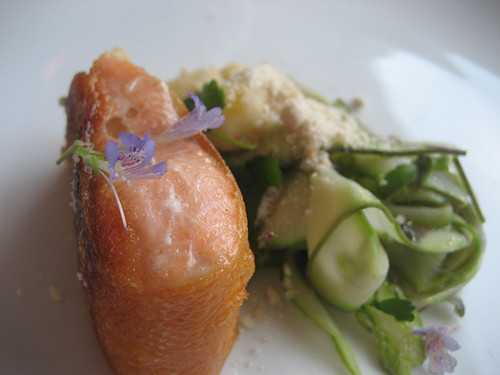
Another fine fish dish, a delicate golden trout with shaved asparagus, ground ivy (!), white sesame, and a little banana puree which was subtle and liqueur-y, plus an unbilled cameo by lavender, I guess. Interestingly, if you ate the shaved asparagus on its own, you didn’t really get an asparagus flavor, it could have been zucchini or something.
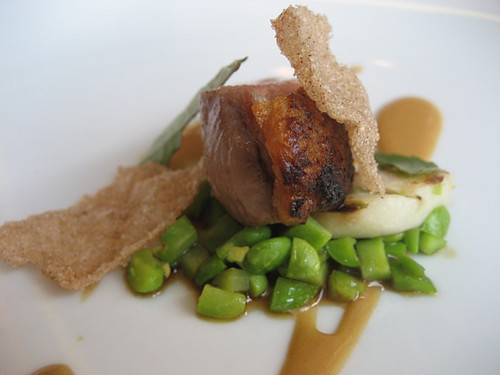
Duck breast with porcini, favas, Worcestershire brown butter and cinnamon crisps; now we were into the savory meats part of the tasting menu, and I liked this a lot although the cinnamon thing seemed out of place, like French toast at the wrong meal.
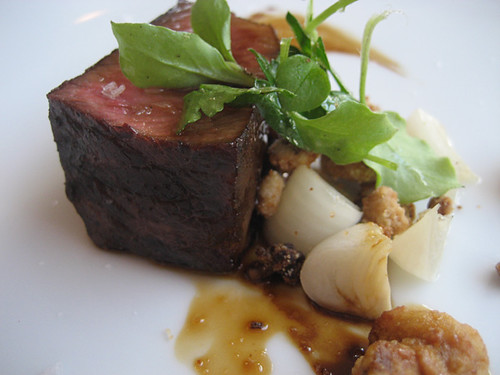
While the accompaniments for this little chunk of wagyu beef could have stayed home, this was all about the deeply flavored, mineral-y beef. Interestingly, the description mentioned marrow here, but we were mystified where it could be in the dish; we finally decided it must be holding the “caraway crumble” together.

This was also my first exposure to Blackbird’s new pastry chef, Patrick Fahy (aspiring pastry chefs, go read Fahy’s bio at the Blackbird site; the answer to How to Get a Job at Blackbird is, apparently, work everywhere, usually two or three at once). I loved the first two, “fruit of the cocoa sorbet” (tasted more like citrus to me, but what do I know), with great little candied cocoa nibs (and having tasted uncandied nibs, trust me, they need candying), cilantro allegedly somewhere in there, and a banana sauce which, again, managed to avoid being too banana-y; this was a wonderful palate cleanser dressed up to go out.
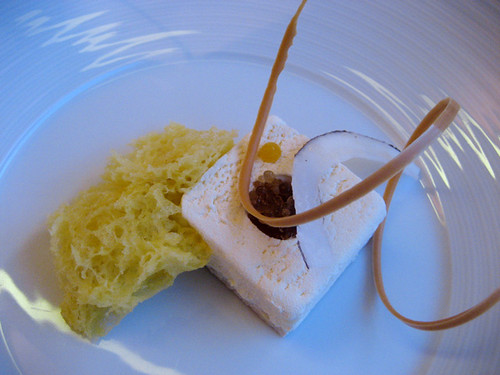
Even more impressive, not to mention playful, was this construction. The sponge at left is a spongecake, apparently cooked in the microwave so it explodes (“Three minutes ago this was batter,” said Ivar the World’s Greatest Waiter); the white square is a white honey parfait with wonderfully tart and gooey passion fruit in the center, and the spiral is caramelized white chocolate. This was a mindblower, lots of textures and flavors that went beyond expectations, a total delight.
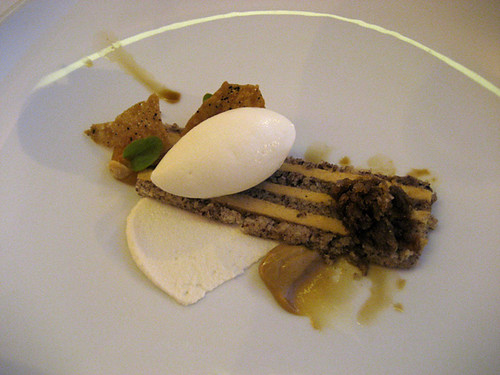
I’m not a great fan of coffee desserts, or coffee anything besides a hot cup first thing in the morning, so I just kind of admired this last one technically; Fahy’s experience at Lutz here in Chicago comes out in the classic-looking hazelnut dacquoise with espresso and chicory flavorings, but it was the apricot kernel sorbet, with its little crunchies of something (don’t know what the kernels actually were), that I liked best.
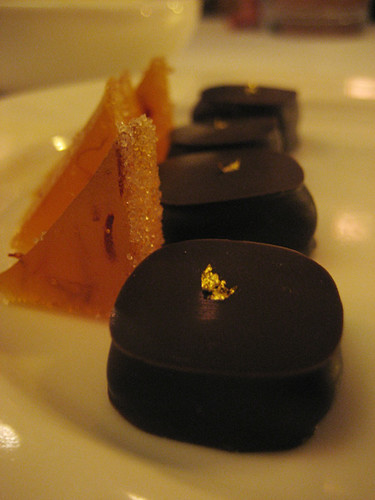
And finally, a little plate of, I think, apricot jellies (really wonderful) and dark chocolates with a liqueur center of some sort (not my thing, usually). We also finished with teas from Roderick Markus; I skipped the $150 pu-erh and had a simple, but really quite impressive and three-dimensional, Japanese green-tea sencha.
(Now, one question: should you do the tasting menu? Clearly it’s less something that Blackbird developed organically (as it is at a place like Alinea, where the entire evening is carefully structured as a series of novel experiences in small portions) than something they started offering in response to customer expectations that every restaurant have one. And everything on it (except maybe the cuttlefish) can stand up to being a full portion. So at the very least I don’t think doing so is essential to the experience, well, unless your vision of the experience involves writing and posting a lot of tasty photos, as mine inextricably does. If you’d rather just tear into a big hunk of that pork or the sturgeon, I wouldn’t blame you.)


 Posted in
Posted in 

